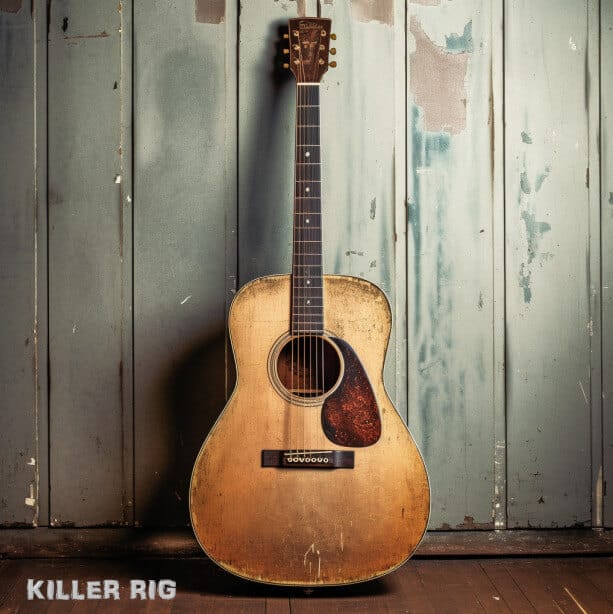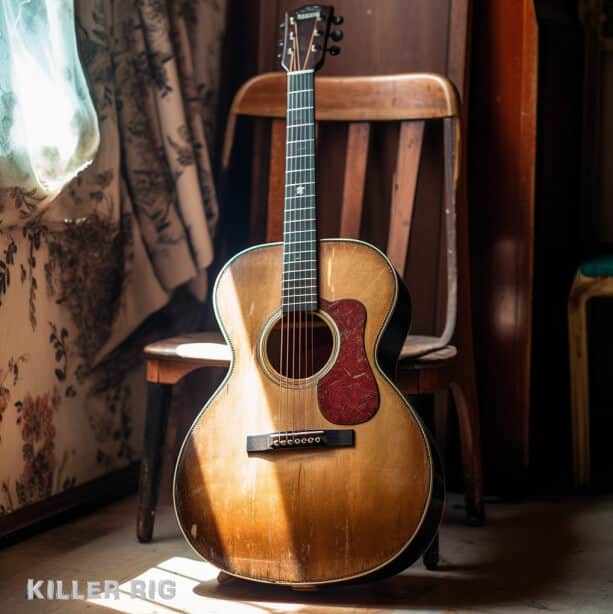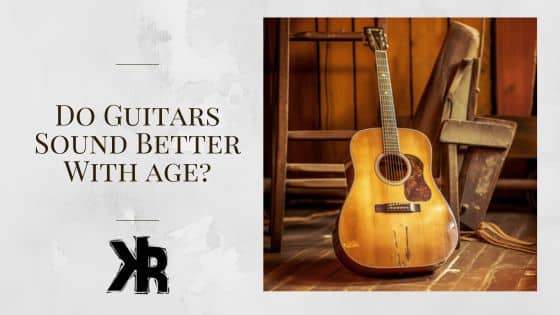Table of Contents
Strumming the strings of an acoustic guitar, feeling its vibration under your fingertips, and experiencing the resonating, mellow hum it produces. It’s an experience, a connection that’s as magical for the novice as it is for the professional musician.
However, nestled within this relationship between musician and instrument is a burning question, a heated debate, that’s as old as the first guitar ever strummed. Does a guitar sound better with age?
In the quest for the ‘perfect tone,’ guitar aficionados and musicians alike often claim that older guitars have a certain richness, a depth to their sound that their younger counterparts can’t quite muster.
But is this acoustic alchemy rooted in reality, or is it simply a romantic notion we’ve strummed and hummed into existence?
In this Killer Rig article, I’ll explore this intriguing aspect of guitar lore. We’ll reveal the science behind the sound, the impact of different timbers, and even what the experts have to say on the matter.
The Guitar Aging Phenomenon
A well-aged guitar can elicit a sense of nostalgia, not just for the music it’s played over the years, but also for the craftsmanship it represents.
There’s something about the worn frets, the beautifully patinaed wood, and the smooth, rounded edges that speaks volumes of its history. But does this translate into a better sound? Let’s unravel the mystery.
The Perceived Improvement in Sound
Many guitarists firmly believe that a guitar is like a fine wine, it gets better with age. The notion is that as a guitar ages, the wood matures, allowing it to resonate more freely and produce a richer, fuller, and vibrant sound.
This belief isn’t entirely baseless. The theory is that as wood ages, it loses moisture, and the loss of moisture can result in a tighter grain structure, which might enhance the guitar’s tone.
In contrast, a new guitar, although meticulously crafted, might not possess the same tonal complexity due to the relative greenness of the wood. But this doesn’t necessarily make it inferior.
A new guitar could have a crispness and clarity to its sound that an older one might lack. Ultimately, the better sound could come down to personal preference.
Related: Find the Best Guitar Colors here!

Why They Don’t Make Them Like They Used To
There’s a certain allure to vintage guitars that transcends their age. It’s not just the old-world craftsmanship that attracts players. It’s also the notion that these guitars possess a special tonal quality that newer models can’t replicate.
One contributing factor could be the quality of the wood used in the past. Historically, guitar manufacturers had access to high-quality, old-growth timber, which is now increasingly rare.
These woods, known for their superior resonance, could contribute to the “they don’t make them like they used to” sentiment.
However, advancements in technology and guitar-making techniques are constantly bridging this gap, offering modern guitars with exceptional sound quality.
It’s important to remember, vintage guitars carry a certain charm, and much of it springs from their rich past. Consider the melodies they’ve strummed out, the spotlighted platforms they’ve seen, and the myriad of skilled fingers they’ve known.
All of these elements blend together, enhancing the allure and the often-believed superior tune they emit.
Unraveling the Marvels of Mahogany and Other Timbers
When it comes to the tonal properties of a guitar, wood plays a crucial role. The type of timber used in its construction can greatly influence the sound produced. So, let’s take a closer look at these timbers and their contribution to a guitar’s sonic appeal.
Timber Types Used in Guitar Manufacturing
A variety of wood types are utilized in the crafting of a guitar, each imparting its wonderful acoustic characteristics. Mahogany, for example, is known for its warm and full-bodied sound.
It has a balanced tone that lends itself to a variety of musical styles, hence its popularity among guitarists.
Other timbers, like spruce, cedar, and rosewood, each have their own attributes. Spruce is known for its crisp articulation and broad dynamic range.
Cedar produces a warm, mellow tone, and rosewood, with its high resonance, is cherished for its rich, deep bass, and sparkling highs.
Has Timber Availability and Quality Changed Over Time?
Timber quality and availability have undoubtedly changed over the years, largely due to factors like deforestation, environmental regulations, and changes in trade laws. In yesteryears, luthiers had access to large swathes of old-growth forests, rich with quality timber.
Nowadays, these supplies are dwindling, and guitar manufacturers have had to adapt, either by using sustainable alternatives or by utilizing technology to maximize the acoustic potential of available woods.
That said, many top guitar manufacturers continue to source high-quality timber, ensuring the sound quality of modern guitars is still top-notch.
Why Certain Older Timbers Become More Resonant
As we’ve hinted before, the age of the timber used in a guitar might have an impact on its sound. Older timber, particularly that sourced from slow-growing, old-growth trees, tends to have a tighter and more uniform grain structure, resulting in better resonance.
This is one reason why some musicians and collectors prize vintage guitars made from these older timbers.
Furthermore, as a guitar ages, the timber undergoes natural changes. The wood dries out and hardens, potentially enhancing the guitar’s resonance and sustain. It’s a slow, organic process that, some argue, contributes to the “matured” sound of an older guitar.
Important Note: While the age and type of timber can influence a guitar’s tone, they aren’t the only factors at play. Everything from the guitar’s design to its construction techniques, and even how it’s been played and cared for, can impact its sound.
The Science Behind the Sound
If you’ve ever wondered why your favorite tune sounds so much sweeter when strummed on an old guitar, it’s time to get a little scientific.
From how age affects the guitar’s structure to the technological advancements enhancing it’s sound, let’s dive into the intricacies of guitar acoustics.
How Age Affects a Guitar’s Structure
As a guitar ages, changes occur on a microscopic level within the structure of the wood, affecting its tonal properties. Over time, wood undergoes a process of drying and hardening, which can lead to improved resonance and vibrational efficiency.
This process can affect the guitar’s soundboard (the top part of the instrument’s body where the strings attach), the most critical component for producing sound.
The soundboard vibrates as the strings are plucked, creating the sound waves that we perceive as music. The older and drier this wood, the more freely it can vibrate, which can result in a richer and more complex tone.
Torrefaction Technology: A Scientific Perspective
While age can naturally enhance a guitar’s sound, modern science has found ways to speed up this process. Torrefaction, or thermal aging, is a process where new wood is baked in a controlled environment, simulating the effects of long-term natural aging.
The result? Wood that boasts tonal characteristics similar to that of a well-aged guitar.
On the other hand, Yamaha’s Acoustic Resonance Enhancement (ARE) technology manipulates the molecular structure of the wood without the use of heat, chemicals, or additives.
It’s another technique aimed at accelerating the aging process, creating guitars that sound ‘played-in’ straight out of the box.
It’s a testament to how far we’ve come in understanding the nuances of guitar acoustics. Plus, how we’ve harnessed this knowledge to create instruments that balance the allure of age-old craftsmanship with cutting-edge technology.
Laminates Vs. Solid Wood Guitars
The debate between solid wood and laminate guitars is as longstanding as the one concerning guitar aging.
The type of material used in the guitar’s construction undoubtedly impacts its sound, durability, and price. But does one age better than the other? Let’s strike the right chord on this topic.
Solid wood guitars are crafted from a single piece of timber. Bringing out the natural tonal qualities of the wood. Their sound is often described as richer and more resonant compared to laminate guitars.
This is because solid wood vibrates more freely, which can enhance the guitar’s tonal complexity. Furthermore, as solid wood ages and dries, its tonal quality can improve, adding depth and volume to the sound.
On the flip side, laminate guitars consist of multiple layers of wood pressed together. They’re typically more durable and less sensitive to temperature and humidity changes, making them a great option for traveling musicians.
However, since laminate doesn’t vibrate as freely as solid wood, these guitars might not have the same tonal depth or the capacity to improve with age. At least not like solid wood guitars.
Factors Influencing the Sound of Aged Guitars
We’ve seen that the type of wood and the aging process can influence the sound of a guitar. However, there are other factors at play that are equally influential. From modern scientific methods to the power of regular play, let’s explore these further.
Torrefaction
As mentioned earlier, torrefaction is a process where wood is subjected to high temperatures in a controlled environment. This treatment mimics the natural aging process, giving the wood a more mature tonal quality.
It’s like fast-forwarding through decades of aging, but in a matter of hours. Although this process doesn’t replicate every aspect of natural aging, it certainly brings the tonal characteristics of new guitars closer to those of their older counterparts.
The Role of Care and Maintenance
The answer, sadly, is yes. An older guitar doesn’t necessarily guarantee a better sound, especially if it’s been poorly maintained.
A guitar requires regular care to keep its sound optimal. Cleaning, correct storage, humidity control, and timely string changes all play a role in preserving its tone.
A neglected guitar, irrespective of its age, can develop issues like warping, cracks, or fret damage. All of which can negatively affect its sound.
Do Guitars Sound Better When Frequently Played?
You’ve probably heard the phrase ‘guitars need to be played.’ There’s some truth to this. Regularly playing a guitar might improve its tone over time. The theory here is that the constant vibrations from playing the guitar help ‘break-in’ the wood, making it more resonant.
So, your 25-year-old guitar that’s been collecting dust in the attic might not sound as good as a frequently played one of the same age.

Hearing from the Experts
When it comes to the intriguing interplay between a guitar’s age and its sound, there are numerous opinions out there. Musicians, luthiers, acoustic scientists, and even casual listeners all have their perspectives. Let’s tune in to what some of these experts have to say.
Expert luthiers, those artisans who craft guitars with meticulous attention to detail, often affirm that the aging of wood can indeed enhance a guitar’s sound. However, they also caution that this isn’t a hard and fast rule.
Factors like the quality of the wood, the construction of the guitar, and its upkeep play equally important roles in determining the instrument’s tone.
No magic, no mystery, just great materials, great craftsmanship, and time!
Dog Wood Guitars
Acoustic scientists, on the other hand, provide a more analytical viewpoint. They confirm that changes do occur in the wood as it ages, affecting its density, stiffness, and moisture content. All of which can influence the guitar’s resonance and sustain.
Yet, they also emphasize that our perception of sound is highly subjective, and what one person may describe as an ‘improved’ tone might not be the same for another.
Final Thoughts
At this point, we’ve traversed the history and science of guitars, delved into their craftsmanship, dissected the impact of different timbers, and even considered the opinions of experts.
So, does a guitar really sound better with age? The answer isn’t as simple as a ‘yes’ or ‘no.’ It’s a melody composed of many notes.
In essence, it comes down to this, every guitar has its own voice, shaped by a symphony of factors. As guitarists, our role is to find the instrument that resonates with our musical soul, be it an antique relic or a brand-new piece of craftsmanship.
After all, music is a language that transcends time, and each guitar, regardless of its age, has a beautiful story to tell. And isn’t that why we fell in love with the six-stringed wonder in the first place?
So here’s to guitars, young and old, and to the music they inspire. Keep on strumming, my friends!

